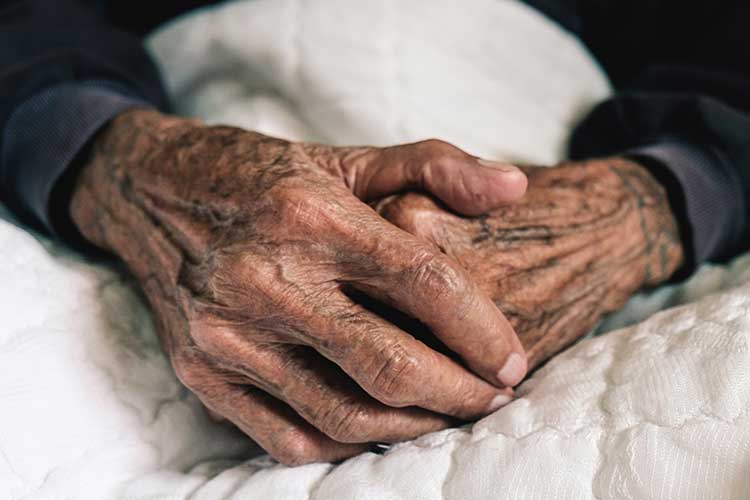‘Human Rights Watch documented several cases in which family members described how relatives with dementia who were taken off medications used to restrain them regained much of their vitality, once again talking and interacting, and staying awake during the day.’
(Brown 2019)
What is Chemical Restraint?
Chemical restraint is the administration of medicine to restrict the movement or decision-making capacity of a person in your care (Dementia Australia 2023).
These medicines, which commonly include psychotropics, anxiolytic/hypnotic agents and antipsychotics, are prescribed for the primary purpose of controlling a person’s behaviour. They are not related to the medical treatment of an illness, condition or disorder (Dementia Australia 2023; ACQSC 2021).

Chemical restraint is a form of restrictive practice.
Around the world, including in Australia, older adults are unnecessarily being prescribed antipsychotics in place of behavioural management and proper treatment for underlying conditions (HRW 2022).
The latest data from the National Aged Care Mandatory Quality Indicator Program reveals that 17.9% of residential aged care recipients are being given antipsychotic medicines. Yet, half of these people have not been diagnosed with psychosis (AIHW 2024).
The Royal Commission into Aged Care Quality and Safety (2019, 2021) identified a 'clear overuse’ and ‘significant over-reliance’ of chemical restraint in aged care, stating that older people urgently need to be protected from these ‘unnecessary’ and ‘potentially harmful’ measures.
The View From the Human Rights Watch
A Human Rights Watch report released in October 2019, “Fading Away”: How Aged Care Facilities Chemically Restrain Older People with Dementia, looked into the use of antipsychotics, benzodiazepines and sedative-hypnotic drugs (known as tranquilisers, sleeping pills or sedatives, and opioid analgesics) as chemical restraints in 35 aged care facilities across Queensland, New South Wales and Victoria.
Through interviews with family members, doctors, nurses and advocates, it uncovered numerous cases of secretive chemical restraint. The author, Bethany Brown, called on the government to ban chemical restraint and to make training compulsory for staff on how to handle the behaviour of residents with dementia.
In many of the case studies featured in the report, family members claimed to have noticed significant and worrying differences in their relatives.
These changes included:
- Deterioration in their condition, such as becoming lethargic and losing the ability to speak.
- Many claimed their relatives slept for longer periods and could not be awakened easily.
- They reported weight loss as a result of the resident not being able to remain awake long enough to eat.
(Brown 2019)
It was ascertained that often, staff did not seek or secure informed consent prior to giving these medications. Many relatives said they only learned of these medications upon receiving pharmacy bills that listed them (Brown 2019).
The report also claimed that those who were taken off chemical restraint medications regained vitality, talked and interacted more, and stayed awake during the day. Unfortunately, others continued to experience the physical and cognitive complications of chemical restraints, such as the loss of muscle strength and the inability to swallow (Brown 2019).
Brown (2019) called for a shift towards person-centred care, citing studies from the United States that found that people with dementia treated with these interventions showed signs of improved quality of life, decreased agitation, improved sleep patterns and improved self-esteem.
What are the Risks of Chemical Restraint?
There are many well-documented adverse consequences associated with chemical restraint. These include:
- Physical injury
- Psychological distress
- Confusion
- Functional decline
- Increased risk of stroke
- Death.
(Dementia Australia 2023)
A clinical trial in the US found that antipsychotic drugs increased the risk of death in older people who had dementia. This included benzodiazepines, which were associated with an increased risk of falls, pneumonia and death in older people (Chang 2019).
Why is the Practice of Chemical Restraint Commonplace?
The HRW report blames understaffing and inadequate training in dementia support for the prominence of chemical restraint in aged care. It claims these factors make it very difficult to take an individualised, comprehensive approach to caring for people with dementia. Therefore, rather than having their needs properly addressed, clients are given medicine to ‘control and subdue’ them. (Brown 2019).

The Australian Government’s Stance on Chemical Restraint
Legal frameworks around chemical restraint are recent; it was not until July 2019 that regulations around chemical restraint were introduced under the Quality of Care Amendment (Minimising the Use of Restraints) Principles 2019 (HRW 2022).
The Amendment aimed to minimise and prevent the inappropriate use of chemical restraint (and other types of restrictive practices) by establishing that it must only be used as a last resort. However, it did not ban the practice completely (HRW 2022; Kurrle 2021).
The Final Report of the Royal Commission into Aged Care Quality and Safety was released in March 2021. In it, the overuse of restrictive practices was identified as a major problem in Australian aged care facilities (HRW 2022; Kurrle 2021).
In response to recommendations made by the Royal Commission, amendments were made to the Aged Care Act 1997 and Quality of Care Principles 2014 in July 2021. These amendments, which replaced the Quality of Care Amendment (Minimising the Use of Restraints) Principles 2019, expanded upon and strengthened the existing restrictive practice regulations (HRW 2022; DoHaAC 2024).
Further amendments to this legislation were made through the Aged Care and Other Legislation Amendment (Royal Commission Response) Act 2022 (DoHaAC 2024).
Note: For further information on current restrictive practices legislation, see the Ausmed Training Module Minimising Restrictive Practices in Residential Aged Care.
As of January 2025, chemical restraint is still allowed in Australia as long as it is used in accordance with legislative requirements.
The practice remains a significant concern and, according to Human Rights Watch (2022), is still widely used across many aged care facilities despite strengthened legislation.
Elaine Pearson, director of Human Rights Watch Australia, has stated that:
‘Policies minimising the use of restraints to modify behaviour are failing to protect older people, showing the need for an outright ban on chemical restraints’.
(HRW 2022)

Chemical Restraint on the World Stage
The terminology ‘chemical restraint’ itself carries a stigma. In healthcare, medicines are not commonly referred to as ‘chemicals’. It is not often said that you are ‘chemically relieving a person with asthma’, but you may hear the phrase ‘chemically restraining a person with dementia’.
By calling psychiatric medicines ‘chemicals’, it differentiates them from other medicines or implies that agitation deserves punishment or subjugation as opposed to healing (Zeller 2017).
Under international human rights law, governments are obligated to respect the dignity of people living with disability, including older people, by recognising them as being on an equal basis with others. This includes respecting their right to live independently without being made to live in an institution and to have all their human rights protected if they decide to stay in institutions such as aged care facilities (HRW 2019).
Test Your Knowledge
Question 1 of 3
Approximately what percentage of aged care residents are being given antipsychotic medicines despite not having a diagnosis of psychosis?
Topics
Further your knowledge
 Free
Free
References
- Aged Care Quality and Safety Commission 2021, Overview of Restrictive Practices, Australian Government, viewed 29 January 2025, https://www.agedcarequality.gov.au/sites/default/files/media/overview-of-restrictive-practices_0.pdf
- Australian Institute of Health and Welfare 2024, Residential Aged Care Quality Indicators – April to June 2024, Australian Government, viewed 29 January 2025, https://www.gen-agedcaredata.gov.au/resources/publications/2024/october/residential-aged-care-quality-indicators-quarterly-report
- Brown, B 2019, ‘ “Fading Away” How Aged Care Facilities in Australia Chemically Restrain Older People with Dementia’, Human Rights Watch, 15 October, viewed 29 January 2025, https://www.hrw.org/report/2019/10/15/fading-away/how-aged-care-facilities-australia-chemically-restrain-older-people
- Chang, C 2019, ‘The Disturbing Use of Drugs to Control Behaviour in Australian Aged Care Facilities’, News.com.au, 16 October, viewed 29 January 2025, https://www.news.com.au/finance/business/the-disturbing-use-of-drugs-to-control-behaviour-in-australian-aged-care-facilities/news-story/2dbdf5ac02c81feb2acc40eb6b4fddf8
- Dementia Australia 2023, ‘Can Aged Care Providers Use Chemical Restraint?’, Dementia Australia News, 5 December, viewed 24 January 2023, https://www.dementia.org.au/about-us/news-and-stories/news/can-aged-care-providers-use-chemical-restraint
- Department of Health and Aged Care 2024, Restrictive Practices in Aged Care – a Last Resort, Australian Government, viewed 29 January 2025, https://www.health.gov.au/topics/aged-care/providing-aged-care-services/working-in-aged-care/restrictive-practices-in-aged-care-a-last-resort
- Human Rights Watch 2022, ‘Australia: Chemical Restraint Persists in Aged Care’, Human Rights Watch, 30 March, viewed 29 January 2025, https://www.hrw.org/news/2022/03/30/australia-chemical-restraint-persists-aged-care
- Kurrle, S 2021, ‘Chemical Restraint: Legislative Changes to “Restrictive Practices” ’, InSight+, 19 July, viewed 29 January 2025, https://insightplus.mja.com.au/2021/26/chemical-restraint-legislative-changes-to-restrictive-practices/
- Royal Commission into Aged Care Quality and Safety 2021, Final Report: Care, Dignity and Respect: Volume 1, Australian Government, viewed 29 January 2025, https://www.royalcommission.gov.au/aged-care/final-report
- Royal Commission into Aged Care Quality and Safety 2019, Interim Report: Neglect: Volume 1, Australian Government, viewed 29 January 2025, https://www.royalcommission.gov.au/system/files/2021-03/interim-report-volume-1.pdf
- Zeller, S 2017, ‘The End of Chemical Restraints: Expert Opinion’, Psychiatry Advisor, 3 March, viewed 29 January 2025, https://www.psychiatryadvisor.com/home/practice-management/the-end-of-chemical-restraints-expert-opinion/

